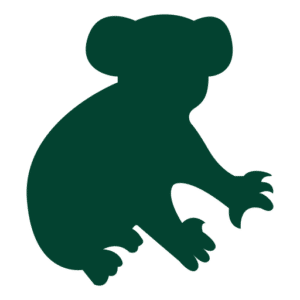This Sanctuary’s beautiful vegetation is mostly Dry Rainforest & Vine Thicket Shrub situated in Lammermoor, approximately 9 kilometres south of Yeppoon, Queensland.
The property covers 8.9 hectares and features vegetation including an abundance of Endangered Semi-evergreen Vine Thicket throughout the Dry Rainforest with an exclusive area of Regional 11.11.18 Endangered Ecosystem. Habitat to other Endangered & protected Flora with mature woodland areas containing species of Eucalypt favoured by koalas, gliders, bats, aves & a variety of many other Fauna Species. A multitude of varieties of mosses, fungi, mistletoe & orchid also inhabitant the Sanctuary, assisting in its health & fertile abundance of this incredible Flora & Fauna Community.
The property, containing large stags, hollows, leaf litter, mature trees for habitat & with all the food sources available, has made it the breeding grounds to an abundance of wildlife including a population of Threatened black-breasted buttonquails (Turnix melanogaster) glossy black-cockatoos (Calyptorhynchus lathami), the powerful owl (Ninox strenua), squatter pigeons (Geophaps scripta), grey headed flying fox & special least concern grey wagtails (Motacilla cinerea) plus many migrating birds protected under the Commonwealth EPBCA being next to a wetland & only 1km from the shoreline.
Formal identification to date includes 5 of the 9 Listed Fauna Species associated with the SEVT Endangered Ecosystem with the possibility of more to be named. Micro & macro bats are also currently a focus for formal identification with potentially as many as 5 individual species sighted on trail cams and observations as well as gliders & some of our interesting retiles noted on site.
This essential habitat is also home to a large population of short-beaked echidnas (Tachyglossus aculeatus) that return to breed in the same burrows year-round, not usually a common occurrence and possibly due to a lack of suitable habitat from extensive land clearing surrounding this property.
A huge range of insects including native bees, wasps, dragon flies, ants, beetles, spiders with many species of butterflies including the Threatened pale imperial hairstreak (Jalmenus eubulus) have been identified. Tree markings throughout show evidence of yellow-bellied gliders (Petaurus australis) and koalas (Phascolarctos cinereus).
A Fauna species list already over a hundred & counting, continues to show the critical importance of this unique property for all who inhabit the Sanctuary that is now surrounded by agriculture & housing development. Often referred as similar to a busy motel for ‘Native Wildlife’ scrambling to find a safe place to not only survive but thrive against all odds.
With less than 2% of this vegetation left in existence within Australia, the protection & rehabilitation of this property is critical for our contribution to Local, State & Commonwealths Biodiversity.



